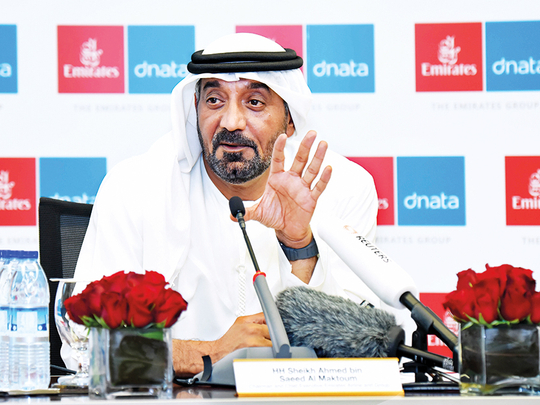
Dubai: The head of Emirates airline said he was optimistic about financial performance in 2018, expecting it to be a “good year” amid improvements in the operating environment.
Shaikh Ahmad Bin Saeed Al Maktoum, President of Dubai Civil Aviation and Chairman and Chief Executive of Emirates airline and Group, said the Dubai-based carrier is expected to benefit from synergies, especially in the summer as a result of its partnership with flydubai.
His comments came as Emirates reported Dh2.8 billion in profits for the financial year ending March 2017, a 124 per cent jump from the Dh1.3 billion recorded a year earlier. Emirates Group reported Dh4.1 billion in profits for the year, up 67 per cent year-on-year, with revenues 8 per cent higher at Dh102.4 billion.
Emirates’ profit for year, up 124% from last year’s Dh1.3b
The increase in earnings came as Emirates benefited from the decline in the US dollar against other currencies, a factor that gave the carrier a Dh661 million boost to revenues.
The growth was also despite a 15 per cent increase in fuel costs, which raised Emirates’ operating costs by 7 per cent during the year. In its statement on financial results, Emirates said its fuel bill increased by 18 per cent year-on-year to reach Dh24.7 billion in 2017.
Fuel remained the biggest cost component for the airline, accounting for 28 per cent of operating costs, up from 25 per cent a year earlier.
Shaikh Ahmad said business conditions in 2017, while improved, “remained tough.”
Emirates Group’s profit for the year, up 67% year on year
“We saw ongoing political instability, currency volatility and devaluations in Africa, rising oil prices which drove our costs up, and downward pressure on margins from relentless competition,” he said.
“On the positive side, we benefited from a healthy recovery in the global air cargo industry, as well as the relative strengthening of key currencies against the US dollar.”
During a media round-table to discuss Emirates’ performance, Shaikh Ahmad also said the company benefited from increased efficiency and synergy benefits from its partnership with flydubai.
“In 2017-2018, our reduced recruitment activity, coupled with restructured ways of working gave us gains in productivity …” he said.
Across Emirates Group’s over 80 subsidiaries, total workforce decline by 2 per cent to reach 103,363 employees, but the chairman said the airline was not facing issues with regards to staff shortage.
A Reuters report on Tuesday said the carrier is facing a cabin crew shortage and is struggling to fully staff some flights, but Shaikh Ahmad refuted that.
“We are operating more efficiently … and this is the reason why. We don’t have any issue of shortage when it comes to pilots or cabin [crew],” he told reporters, adding that a 2 per cent drop in total workforce was “normal”.
Analysts said the results validate the efficiency of Emirates’ business model and its ability to adapt to the changing business environment. However, that is not to say that the carrier will see smooth sailing in the next year.
Andrew Charlton, managing director of Geneva-based Aviation Advocacy, said he expected to see a lot of consolidation in the future and steady growth.
“For better or worse, the airline industry denominates many of its payments in US dollar, so the exchange rate matters. The fuel price is on the way up, in part driven by the rising tensions in the region,” he told Gulf News via email.
“The region is also subject to rising tensions and the political outlook is not clear.”
Though Emirates benefited from a weaker dollar in 2017, that may change this year, with some currency experts expecting the dollar to be bottoming out.
For Emirates, financially, the group closed the year with Dh20.4 billion of cash assets.
The group announced it will give out bonuses to its employees, equivalent to five weeks’ salary.










